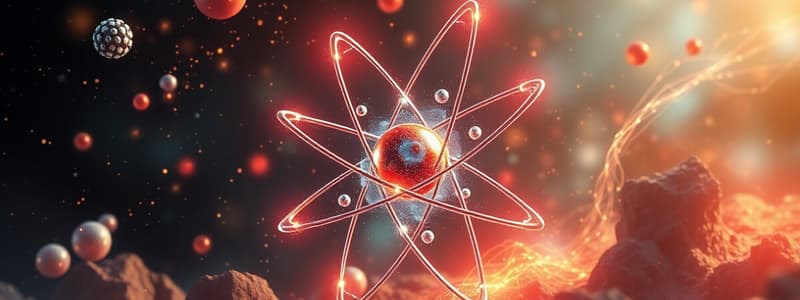Podcast
Questions and Answers
What does the Quantum Mechanical Model indicate about the behavior of electrons?
What does the Quantum Mechanical Model indicate about the behavior of electrons?
- Electrons can only be found in dense regions of the atom.
- Electrons have predictable paths that can be calculated.
- Electrons exist as probability clouds representing likely locations. (correct)
- Electrons have fixed orbits around the nucleus.
Which limitation is associated with Bohr's model of the atom?
Which limitation is associated with Bohr's model of the atom?
- It accurately depicts the behavior of multi-electron atoms.
- It suggests electrons can only have certain velocities.
- It cannot account for electron behavior beyond single-electron systems. (correct)
- It allows for electrons to orbit at any distance from the nucleus.
In Bohr's model, what happens when an electron jumps between energy levels?
In Bohr's model, what happens when an electron jumps between energy levels?
- The electron's mass increases significantly.
- The electron absorbs or releases energy. (correct)
- The electron travels through the nucleus.
- The electron disappears temporarily.
Which of the following represents a type of qualitative data gathering method?
Which of the following represents a type of qualitative data gathering method?
What is the first step in conducting a scientific investigation?
What is the first step in conducting a scientific investigation?
How does Rutherford's model differ fundamentally from Thomson's Plum Pudding Model?
How does Rutherford's model differ fundamentally from Thomson's Plum Pudding Model?
What new atomic structure did Rutherford's model introduce?
What new atomic structure did Rutherford's model introduce?
Which statement best describes Dalton's view of atoms?
Which statement best describes Dalton's view of atoms?
What led to the development of Thomson's Plum Pudding Model?
What led to the development of Thomson's Plum Pudding Model?
How does Thomson's model of the atom compare to Dalton's model?
How does Thomson's model of the atom compare to Dalton's model?
What characteristic of Dalton's Atomic Model is considered a limitation?
What characteristic of Dalton's Atomic Model is considered a limitation?
What does the Quantum Mechanical model state about the arrangement of electrons?
What does the Quantum Mechanical model state about the arrangement of electrons?
Which of the following is NOT a feature of Dalton's Atomic Model?
Which of the following is NOT a feature of Dalton's Atomic Model?
Flashcards are hidden until you start studying
Study Notes
Rutherford's Nuclear Model
- Proposes a centralized, positively charged nucleus at the atom's core, with electrons orbiting around it.
- Differs from Thomson's Plum Pudding Model, which depicted electrons embedded in a positively charged sphere.
Key Features of Dalton's Atomic Model
- Describes atoms as solid, indivisible spheres unique to each element.
- Atoms combine in whole number ratios to create compounds and are rearranged in reactions, not destroyed.
- Lacks consideration for subatomic particles like protons, neutrons, and electrons.
Thomson's Plum Pudding Model
- Emerged from the discovery of the electron, a negatively charged particle.
- Depicts the atom as a positively charged sphere with electrons embedded within it, contrasting Dalton's solid sphere model.
Quantum Mechanical/Electron Cloud Model
- Electrons exist in a "cloud" around the nucleus, providing a probabilistic map of their locations.
- Cannot pinpoint exact electron paths; only probabilities of their presence.
- Requires advanced mathematics for calculating electron probabilities, indicating limitations in predictability.
Bohr's Planetary Model
- Illustrates atoms as resembling a solar system, with a dense nucleus and electrons in specific orbits.
- Electrons can only occupy certain energy levels or shells, absorbing or releasing energy to transition between them.
- Cannot account for behaviors in multi-electron atoms, showcasing limitations.
Classification of Matter
- Distinction between compounds (chemically bonded elements) and elements (pure substances).
Steps for Scientific Investigation
- Identify problems to address.
- Gather data and make observations.
- Formulate hypotheses based on initial findings.
- Conduct experimentation to test hypotheses.
- Organize and analyze collected data.
- Draw conclusions to understand results.
- Communicate findings and applications of the research.
Data Gathering Methods
- Survey, Experiment, Interview, Observation as methods for data collection.
Types of Data
- Quantitative data: Numerical information measurable and analyzed statistically.
- Qualitative data: Descriptive information collected through observation or interviews, offering insights into non-numerical aspects.
Studying That Suits You
Use AI to generate personalized quizzes and flashcards to suit your learning preferences.




